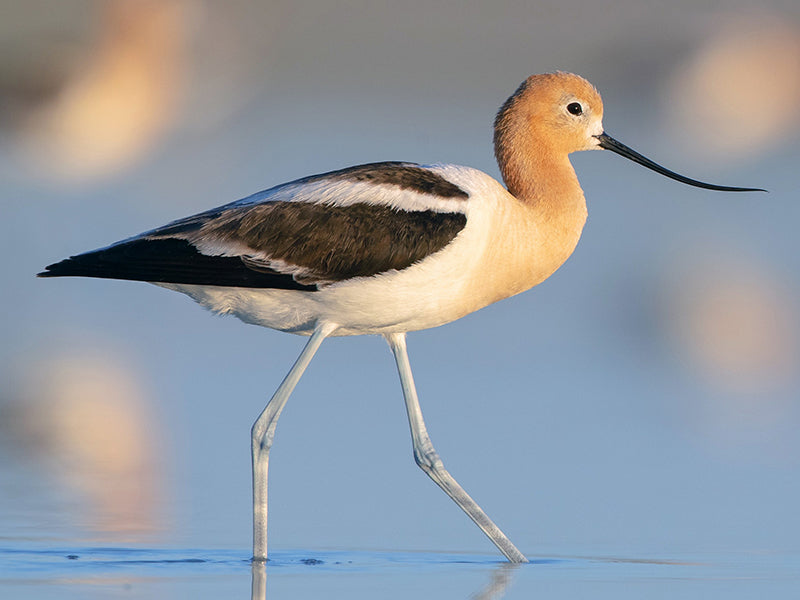Avocets and Stilts
| Order: CHARADRIIFORMES - Family: RECURVIROSTRIDAE |
| 7 Species currently existing - 1 in region + 1 vagrant |
Avocets and stilts are both elegant, long-legged wading birds that belong to the family Recurvirostridae. Here are some key points about avocets and stilts: Read in Spanish
AVOCETS
Avocets are known for their distinctive, upward-curving bills that they use to sweep through shallow water, mud, or soft substrates to find small invertebrates and crustaceans. They have long, slender legs and black-and-white plumage, with a striking contrast between their white bodies and black wing tips. During the breeding season, their heads and necks turn rusty or cinnamon-colored.
Habitat: Avocets are commonly found in shallow coastal lagoons, mudflats, estuaries, and salt pans. They prefer habitats with saline or brackish water and exposed mudflats where they can easily find their prey by using their specialized bills to probe in the soft substrate.
Diet: Avocets are primarily carnivorous and feed on a variety of aquatic invertebrates, including insects, crustaceans, mollusks, and small fish. They sweep their bills from side to side as they walk in shallow water, using a tactile sense to detect and capture prey.
Behavior: Avocets are social birds that often form large flocks, especially during migration and wintering periods. They are known for their graceful wading and foraging behavior, moving systematically through shallow water while sweeping their bills. Avocets are also known for their intricate courtship displays, which involve ritualized movements and vocalizations.
Reproduction: Avocets construct shallow nests on the ground in open areas near water. Both parents participate in incubating the eggs and raising the chicks. They are protective of their nesting sites and will aggressively defend their young from predators.
STILTS
Physical Characteristics: Stilts are characterized by their exceptionally long, slender legs and necks, which allow them to wade in deeper water compared to many other wading birds. They have straight bills that are often used for capturing small fish, insects, and crustaceans. Stilts have black-and-white or brown-and-white plumage, providing good camouflage in their wetland habitats.
Habitat: Stilts are typically found in freshwater or saltwater habitats such as marshes, wetlands, mudflats, and shallow coastal areas. They prefer areas with open water where they can wade and feed on aquatic prey while avoiding predators.
Diet: Stilts are primarily carnivorous and feed on a diet consisting of aquatic invertebrates, small fish, crustaceans, and insects. They use their long bills to probe in the water, mud, or vegetation to catch prey.
Behavior: Stilts are agile and adept at walking and foraging in water, using their long legs to navigate through various depths. They are known for their elegant and graceful movements as they search for food. Stilts may be seen in pairs or small groups, particularly during the breeding season.
Reproduction: Stilts typically build their nests on the ground in shallow water or in emergent vegetation. They lay camouflaged eggs and both parents share incubation and chick-rearing duties. Stilts are vigilant parents and will actively protect their nest and young from potential threats.
Avocets and stilts are fascinating wading birds known for their distinctive physical characteristics, specialized feeding behaviors, and elegant wading movements. They play important roles in aquatic ecosystems by helping to control populations of invertebrates and contributing to the overall biodiversity of wetland habitats. Avocets and stilts are valued for their beauty and ecological significance and are popular subjects for birdwatchers and nature enthusiasts.

American Avocet
Recurvirostra americana
Spanish Name: Avoceta Americana
Size: 18 in | 46 cm
Habitat: Lagoons and shallow freshwater of the Caribbean coast.
Height: Sea level
Photo: © Ian Davies eBird S70014009 Macaulay Library ML 276543461

Black-winged Stilt
Himantopus himantopus
Spanish Name: Cigüeñela Alinegra
Size: 15 in | 38 cm
Habitat: Marshes, freshwater lagoons.
Height: <1500 m
Photo: © Luis A. Materon

